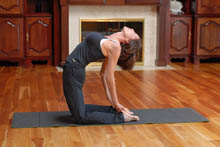How to “Boost” Your Health Just by Sitting Less
by www.SixWise.com
Most people are well aware of the recommendations to get plenty of exercise; 30 minutes of activity at least five days a week is the typical recommendation. But what about the other 16 or so hours that you’re awake?
|

Americans spend an average of eight hours each day sitting … a move that could easily be harming your health.
|
How do you spend those?
Researchers are finding more and more that what you do during these hours is very important to your health … and your waistline. And if you spend the majority of that time sitting -- at work, in the car, watching TV, relaxing -- even a 30-minute date with the treadmill may not be enough to counteract its negative effects.
What’s Wrong With Sitting?
Sitting is not intrinsically harmful, until you do it for hours on end every day. As written by researchers in the British Journal of Sports Medicine:
“Recent evidence underlines the importance of also focusing on sedentary behaviors—the high volumes of time that adults spend sitting in their remaining "non-exercise" waking hours. We provide a brief overview of recent evidence for the distinct relationships between ‘too much sitting’ and biomarkers of metabolic health and, thus, with increased risk of type 2 diabetes, cardiovascular disease and other prevalent chronic health problems.”
A separate series of studies conducted by Theodore Zderic, a post-doctoral researcher, and his research team also looked into the impacts of inactivity. Their research showed prolonged sitting:
- Had negative effects on fat and cholesterol metabolism
- Stimulated disease-promoting processes
Further, they found exercising for even an hour a day was not enough to reverse these effects!
“The enzymes in blood vessels of muscles responsible for 'fat burning' are shut off within hours of not standing," Marc Hamilton, an associate professor of biomedical sciences, told ScienceDaily. "Standing and moving lightly will re-engage the enzymes, but since people are awake 16 hours a day, it stands to reason that when people sit much of that time they are losing the opportunity for optimal metabolism throughout the day."
This may help explain why a study in the International Journal of Obesity and Related Metabolic Disorders found those who had high daily levels of sitting (7.4 hours or more) were significantly more likely to be overweight or obese than those who reported low daily sitting levels (less than 4.7 hours a day).
Sitting Less May Extend Your Lifespan
A study in the journal Medicine and Science in Sports and Exercise linked sitting time with a greater risk of death in more than 17,000 Canadians.
Even after accounting for physical activity levels outside of work, body mass index, age, sex, drinking alcohol and smoking, the mortality risk was 1.54 times higher among those who spent almost all of the day sitting compared with those who spent almost no time sitting, the researchers found.
Those who were considered active (at least 30 minutes of moderate-intensity exercise five days a week) had a lower risk of mortality over the 12 years of follow up as well.
Surprisingly, however, only 5 percent of participants compensated for the time they spent sitting at work through exercise. And even among those who did, the risk of premature death increased depending on how much sedentary time they had in their day.
So logic would suggest that the more you get up off your tush, the longer and healthier your life may be!
What Counts as “Sedentary”?
The average person spends eight hours in sedentary behaviors every day, with the worst offenders being older adolescents (16- to 19-year-olds) and adults aged 60 and over. These two age groups spend about 60 percent of their time being sedentary.
So what counts as sedentary behavior? Examples include:
- Watching TV
- Playing video games
- Using the computer
- Reading
- Doing homework
- Driving or riding in a car
Hamilton suggests that as the health risks of prolonged sitting become more widely known, health campaigns will begin that advertise limiting your sitting time, just as they recommend limiting your exposure to secondhand smoke.
|

Take the opportunity to stand during the day, rather than sit, as often as you can.
|
“Because our research reveals that too little exercise and excessive sitting do not change health by the same genes and biological mechanisms, it offers hope for people who either are not seeing results from exercise or can not exercise regularly. The lifestyle change we are studying is also unlike exercise because it does not require that people squeeze an extra hour into their days and/or get sweaty at the gym, but instead improving the quality of what they already are doing,” Hamilton told ScienceDaily.
“One misrepresentation is that people tend to say 'I sit all the time, so your studies suggest that I can't even work,' but Ben Franklin and Thomas Jefferson showed us that you can be very productive and still do great work in an office with a 'standing' desk,” he continues.
Tips for Sitting Less
|
Get Moving, and Stop Sitting, With SheaNetics

Each nearly one hour workout is a new blend of the-best-of-the-best from Yoga, Pilates, Tai Chi, Martial Arts, Gyro-Kinesis, Dance and MORE -- guiding you through unique sequences of movements that strengthen, sculpt, build core and increase flexibility!
You can do these movements throughout your day to keep moving, and stop sitting … try it in your office or pop in this DVD instead of watching television.
Separately (Each) List Price ($95.95)
Your Special Price Now Just $69.95!*
NEARLY A 30% SAVINGS
|
If you work all day at a computer or have long commutes, it can be difficult to rearrange your day to include less sitting, so take the opportunity to stand rather than sit as often as you can. Stand while watching your kids play at the park, stand while you talk on the phone or watch TV, etc. Also, take “standing breaks” often.
“Commonsense might suggest that it may be prudent to try to minimize prolonged sitting with 5-minute breaks every hour,” researchers write in the British Journal of Sports Medicine.
The Mayo Clinic also points out that your body can only tolerate being in one position for about 20 minutes before it starts to feel uncomfortable. So about every 15 minutes, stand, walk around or change your position for at least 30 seconds.
You can also easily incorporate some of the movements from Sheanetics into your daily routine. SheaNetics, founded by fitness expert Shea Vaughn, blends ancient and contemporary movements with eastern philosophy, creating a stylized approach to fitness designed to improve the quality of today’s western living.
We recommend popping a SheaNetics DVD into your computer at work and completing a five- or 10-minute segment of the video every couple of hours throughout your workday. Most of the moves can be done right in your office, even if you have very little space or privacy. (FIRST Time Ever: MySheanetics.com has agreed to provide FREE SHIPPING … only until November 1).
You can also incorporate some simple yet highly beneficial
|

Jacques and His Wife, Dorothee Lavoie
|
stretches into your daily routine. In 15-20 minutes you can even complete Jacques Gauthier’s wonderful Stretching Toward a Healthier Life DVD ONLY $29.79 Plus FREE SHIPPING!, which helps you to keep your body out of a sedentary position and moving instead.
It may take a bit of creativity and a concerted effort to break your sitting routine, but once you do you’ll likely benefit from life-long health improvements.
Recommended Reading
How to Sit at a Desk All Day and Still be Healthy
Americans Spend HOW Many Hours a Day Watching ‘Screens’? The Consequences … and Help
Sources
British Journal of Sports Medicine 2009;43:81-83
American College of Sports Medicine May 28, 2009
ScienceDaily.com June 1, 2008
ScienceDaily.com November 20, 2007